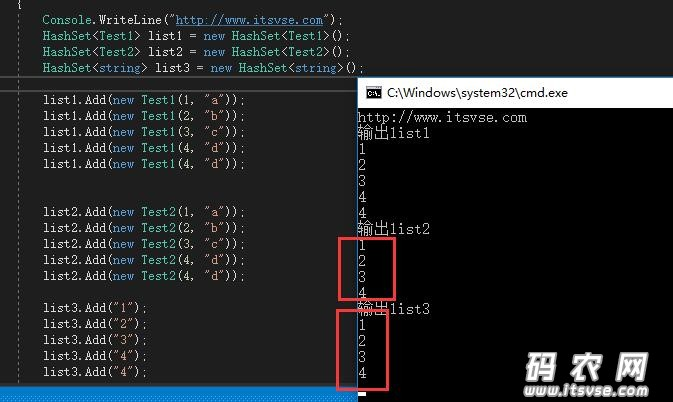class Program
{
static void Main(string[] args)
{
Console.WriteLine("http://www.itsvse.com");
HashSet<Test1> list1 = new HashSet<Test1>();
HashSet<Test2> list2 = new HashSet<Test2>();
HashSet<string> list3 = new HashSet<string>();
list1.Add(new Test1(1, "a"));
list1.Add(new Test1(2, "b"));
list1.Add(new Test1(3, "c"));
list1.Add(new Test1(4, "d"));
list1.Add(new Test1(4, "d"));
list2.Add(new Test2(1, "a"));
list2.Add(new Test2(2, "b"));
list2.Add(new Test2(3, "c"));
list2.Add(new Test2(4, "d"));
list2.Add(new Test2(4, "d"));
list3.Add("1");
list3.Add("2");
list3.Add("3");
list3.Add("4");
list3.Add("4");
Console.WriteLine("输出list1");
foreach (var item in list1)
{
Console.WriteLine(item.id);
}
Console.WriteLine("输出list2");
foreach (var item in list2)
{
Console.WriteLine(item.id);
}
Console.WriteLine("输出list3");
foreach (var item in list3)
{
Console.WriteLine(item);
}
Console.ReadKey();
}
}
public class Test1
{
public Test1(long i,string str)
{
this.id = i;
this.a = str;
}
public long id { get; set; }
public string a { get; set; }
}
public class Test2
{
public Test2(long i, string str)
{
this.id = i;
this.a = str;
}
public long id { get; set; }
public string a { get; set; }
public override bool Equals(object obj)
{
Test2 e = obj as Test2;
return this.id == e.id && this.a == e.a;
}
public override int GetHashCode()
{
return this.id.GetHashCode() + this.a.GetHashCode();
}
}

1,如果hash码值不相同,说明是一个新元素,存;
2,如果hash码值相同,且equles判断相等,说明元素已经存在,不存;
3,如果hash码值相同,且equles判断不相等,说明元素不存在,存;
我们Test2对象,重写了对象的的equals和hashCode方法。这里让Test2对象,只要是id和a相同就认为是相同的实例,当然也可以是其他,这就要看具体需求